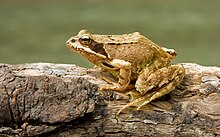| Common frog | |
|---|---|

| |
| Scientific classification | |
| Domain: | Eukaryota |
| Kingdom: | Animalia |
| Phylum: | Chordata |
| Class: | Amphibia |
| Order: | Anura |
| Family: | Ranidae |
| Genus: | Rana |
| Species: | R. temporaria
|
| Binomial name | |
| Rana temporaria | |
| Subspecies | |
| |

| |
| Distribution of Rana temporaria in Europe | |
The common frog or grass frog (Rana temporaria), also known as the European common frog, European common brown frog, European grass frog, European Holarctic true frog, European pond frog or European brown frog, is a semi-aquatic amphibian of the family Ranidae, found throughout much of Europe as far north as Scandinavia and as far east as the Urals, except for most of the Iberian Peninsula, southern Italy, and the southern Balkans. The farthest west it can be found is Ireland. It is also found in Asia, and eastward to Japan. The nominative, and most common, subspecies Rana temporaria temporaria is a largely terrestrial frog native to Europe. It is distributed throughout northern Europe and can be found in Ireland, the Isle of Lewis and as far east as Japan.[2]
Common frogs metamorphose through three distinct developmental life stages — aquatic larva, terrestrial juvenile, and adult. They have corpulent bodies with a rounded snout, webbed feet and long hind legs adapted for swimming in water and hopping on land. Common frogs are often confused with the common toad (Bufo bufo), but frogs can easily be distinguished as they have longer legs, hop, and have a moist skin, whereas toads crawl and have a dry 'warty' skin. The spawn of the two species also differs, in that frog spawn is laid in clumps and toad spawn is laid in long strings.
There are 3 subspecies of the common frog, R. t. temporaria, R. t. honnorati and R. t. palvipalmata. R. t. temporaria is the most common subspecies of this frog.
- ^ Kuzmin, S., Ishchenko, V., Tuniyev, B., Beebee, T., Andreone, F., Nyström, P., Anthony, B.P., Schmidt, B., Ogrodowczyk, A., Ogielska, M., Bosch, J., Miaud, C., Loman, J., Cogalniceanu, D., Kovács, T. & Kiss, I. (2009). Rana temporaria (errata version published in 2016). The IUCN Red List of Threatened Species 2009: doi:10.2305/IUCN.UK.2009.RLTS.T58734A11834246.en
- ^ "Common frog, grass frog". Nature Wildfacts. BBC. Archived from the original on 28 October 2002. Retrieved 9 August 2007.
